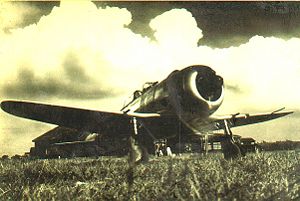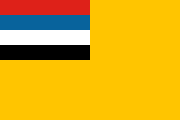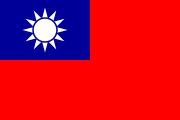Nakajima Ki-44
| Ki-44 | |
|---|---|
 |
|
| Role | Fighter aircraft |
| Manufacturer | Nakajima |
| First flight | August 1940 |
| Introduced | 15 September 1941 |
| Retired | 1945 |
| Primary user | Imperial Japanese Army Air Force |
| Produced | 1940-1944 |
| Number built | 1,225 |
The Nakajima Ki-44 Shōki (鍾馗) (Demon Queller) was a single-engined fighter aircraft used by the Imperial Japanese Army Air Force in World War II, first flying in August 1940 and entering service in 1942. The Allied codename was "Tojo"; the Japanese Army designation was "Type 2 single-seat fighter" (二式単座戦闘機).
In contrast to its predecessor, the nimble Ki-43, the Ki-44 was designed for speed and climbing ability and was used to intercept high-flying B-29 bombers. With its poor visibility on the ground, weak armament, and high landing speed, it was generally disliked by pilots; its oversized engine and diminutive tail made it in some eyes one of the more unattractive aircraft of its class.
Contents |
Design and development
Nakajima began development of the Ki-44 in 1940 solely as an interceptor with emphasis being placed on speed and climb rather than on maneuverability. The Japanese Army Air Force specification called for a maximum speed of 373 mph at 13,125 ft, to be attained in five minutes. A set of “butterfly” combat flaps was fitted for improved maneuverability. Armament consisted of a pair of 7.7 mm and a pair of 12.7 mm machine guns.
The engine selected for the new interceptor was Nakajima's Ha-41 fourteen-cylinder double-row radial, originally intended for bomber aircraft. Although the Ha-1 was not the ideal choice due to its large diameter cross section, the design team was able to marry this engine to a much smaller fuselage with a narrow cross section. In order to achieve its design goals, the wing area was relatively small leading to a high wing loading and a comparatively high landing speed that could be daunting to the average Japanese pilot.
The first Ki-44 prototype flew in August 1940 and while the first test flights were generally encouraging, with handling considered acceptable considering the high wing loading. However, the high landing speed and restricted forward visibility due to the big engine while taxiing on the ground, was problematic.
Operational history
The pre-production aircraft and two of the prototypes were turned over to the Army for service trials on 15 September 1941. Its operative life commenced with one experimental unit, the 47th Chutai (Independent Air Company) ("Kawasemi Buntai", Kingfisher Unit) sent to Saigon, Indochina in December 1941 with nine aircraft under the command of Major Toshio Sakagawa.
The unit later became the 47th Sentai, when flying home defense in Japan. More aircraft were later sent to China, and others were used in defense of oil wells in Sumatra, Indonesia, the China-Burma-India theater of operations, Philippines, Japanese metropolitan defense, mainly concentrated around Japan's large industrial cities and even Kamikaze operations in the last stages of the war.
The 2c version "Tojos," armed with heavy cannon, were used against B-29s by one special kamikaze unit (a company of four aircraft minimum[1]) of the 47th Sentai, which specialized in bomber collision tactics, the Shinten unit ("Shinten Seiku Tai"(Sky Shadow) 47th Sentai (Air Regiment) based at Narimasu airfield), during the defense of Tokyo.
The Nakajima Ki.44 once equipped 12 sentais of the Japanese Army Air Force (the 9th, 22nd, 23rd, 29th, 47th, 59th, 64th, 70th, 85th, 87th, 104th and 246th Air Regiments) which saw action before their (partial) replacement with Nakajima Ki.84 "Hayate"s for the final battles of the war. The Manchoukouan Air force also received some examples of these aircraft during wartime.
Postwar Use
After World War II, the nationalist Chinese 18th Squadron of the 6th Group was equipped with Ki-44s formerly of the 9th Sentai, which had disbanded in Nanking, and of the 29th Sentai, which had disbanded at Formosa[2] and they participated in the Chinese Civil War. The People's Liberation Army Air Force managed to get hold of aircraft formerly belonging to 22th and 85 entai, who had disbanded in Chosen, the Japanese name for Korea during their occupation (1910-1945) of that country. These aircraft were flown by Japanese mercenary pilots, who used them until the last two Ki-44s finally retired in the early 1950s.
Variants
- Ki-44
- Prototype.
- Ki-44
- Model preseries for evaluation.
- Ki-44 Type I
- was powered by a 930 kW (1,250 hp) Nakajima Ha-41 engine, and had a maximum speed of 580 km/h (363 mph). Armament consisted of two 7.7 mm Type 89 machine guns and two 12.7 mm Ho-103 machine guns placed in the wing.
- Ki-44 Ia
- Fighter Type 2 of Army. (Mark Ia).
- Ki-44 Ib
- Mark Ib.
- Ki-44 Ic
- modified version.
- Ki-44 Type II
- had a 1,074 kW (1,440 hp) Nakajima Ha-109 engine with a top speed of 604 km/h (378 mph), and four 12.7 mm Type I machine guns.
- Ki-44 II
- prototype—engine Nakajima Ha-109 of 1,520 hp (1130 kW).
- Ki-44 IIa
- Mark 2a.
- Ki-44 IIb
- Ki-44 IIc
- (Mark 2c) first version with heavy armament - four 20 mm Ho-3 cannons or two 12.7 mm Ho-103 machine guns and two 40 mm Ho-301 cannon.
- The four Ho-3 cannons were the most effective against B-29s. The 20x125 Ho-3 round gave the 144 g ave. (127/140/164) shell (7% HE ave.) a range of 900 m and a muzzle velocity of 820 m/s. The rate of fire for the wing-guns was 400 rpm, while the synchronized cowl-mounted pair were much slower (perhaps under 272 rpm each). This equals 23 rounds per second for the four cannon against approximately 52 rps for the standard four machine gun version), but the firepower advantage (around 2.5x per second stronger punch - including blast, for the same number of guns and only about half the ammo per second) more than compensated against bombers.
- Against small fighters at speed, the sparse firing pattern density would be less than ideal. Double magazines could hold 100 rpg of 20 mm (20x125) ammunition - not to be confused with the rapid fire Ho-5 20 mm (20x94) ammunition - which was better for dog fights. No 20 mm cannon in World War II had a higher rate of fire than the new Ho-5, but its punch per hit was less than that of the high velocity Ho-3.
- Ki-44 IIIa
- (Mark 3a) engine of 2,000 hp (1,500 kW) and four 20 mm Ho-5 cannons.
- Ki-44 IIIb
- (Mark 3b) two 20 mm Ho-5 cannons and two 37 mm Ho-203 cannons.
Total production: 1,225
Operators
- Wartime
 Manchukuo
Manchukuo
- Manchukuo Air Force
- Imperial Japanese Army Air Force
- 9th Sentai
- 22nd Sentai
- 23rd Sentai
- 29th Sentai
- 47th Chutai/Sentai
- 59th Sentai
- 64th Sentai
- 70th Sentai
- 85th Sentai
- 87th Sentai
- 104th Sentai
- 246th Sentai
- Akeno Flight Training School
- Hitachi Flight Training School
- Post-War
 China
China
- Chinese Nationalist Air Force operated some captured aircraft
- People's Liberation Army Air Force operated some aircraft captured from IJAAF and CNAF.
- Indonesian People's Security Force (IPSF - Indonesian pro-independence guerrillas) captured a small number of aircraft at numerous Japanese air bases in 1945, including Bugis Air Base in Malang (repatriated 18 September 1945). Most aircraft were destroyed in military conflicts between the Netherlands and the newly proclaimed-Republic of Indonesia during the Indonesian National Revolution of 1945-1949.
Specifications (Ki-44-IIb)
General characteristics
- Crew: one, pilot
- Length: 8.84 m (29 ft)
- Wingspan: 9.45 m (31 ft 01 in)
- Height: 3.12 m (10 ft 23 in)
- Wing area: 15 m² (161 ft²)
- Empty weight: 2,105 kg (4,641 lb)
- Loaded weight: 2,764 kg (6,094 lb)
- Max takeoff weight: 2,995 kg (6,602 lb)
- Powerplant: 1× Nakajima Ha-109 radial engine, 1,133 kW (1,519 hp)
Performance
- Maximum speed: 605 km/h (376 mph)
- Cruise speed: 400 km/h (249 mph)
- Stall speed: 150 km/h (93 mph)
- Range: 1,700 km (1,060 miles)
- Service ceiling 11,200 m (36,750 ft)
- Rate of climb: 5,000 m--4 min 17 sec (3,940 ft/min)
- Wing loading: 200 kg/m² (41 lb/ft²)
- Power/mass: 0.38 kW/kg (0.13 hp/lb)
Armament
- 4 × 12.7 mm Ho-103 machine guns, two synchronized cowl mounted (perhaps 657 rpm rate each), and one in each wing (900 rpm rate of fire each), 760 rounds in all. The 12.7x81 cartridge propelled the 35.4 g AP bullet 760 m/s, the 38 g HE 796 m/s, and the 33 g HE (2.2%) 770 m/s, with an effective firing range of 750 m. Not always reliable.
See also
Related development Nakajima Ki-84
Comparable aircraft
- Focke-Wulf Fw 190
- Mitsubishi J2M
- Polikarpov I-180
- Republic P-43
References
Notes
Bibliography
- Bueschel, Richard M. Nakajima Ki.44 Shoki Ia,b,c/IIa,b,c in Japanese Army AIr Force Service. Canterbury, Kent, UK: Osprey Publishing Ltd., 1971. ISBN 0-85045-0-40-3. (Also published by Atglen, PA: Schiffer Books, 1996. ISBN 0-887409-14-8.)
- Brindley, John F. Nakajima Ki-44 Shoki ('Tojo'), Aircraft in Profile no.255. Windsor, Berkshire, UK: Profile Publications Ltd., 1973. No ISBN.
- Francillon, René J. Japanese Aircraft of the Pacific War. London: Putnam & Company Ltd., 1970 (second edition 1979). ISBN 0-370-30251-6.
- Green, William. War Planes of the Second World War, Volume Three: Fighters. London: Macdonald & Co. (Publishers) Ltd., 1961 (seventh impression 1973). ISBN 0-356-01447-9.
- Green, William and Gordon Swanborough. WW2 Aircraft Fact Files: Japanese Army Fighters, Part 2. London: Macdonald and Jane's Publishers Ltd., 1977. ISBN 0-354-01068-9.
- "Nakajima Ki.44" (in Japanese). Maru Mechanic No. 9, March 1978.
External links
|
|||||
|
||||||||||||||